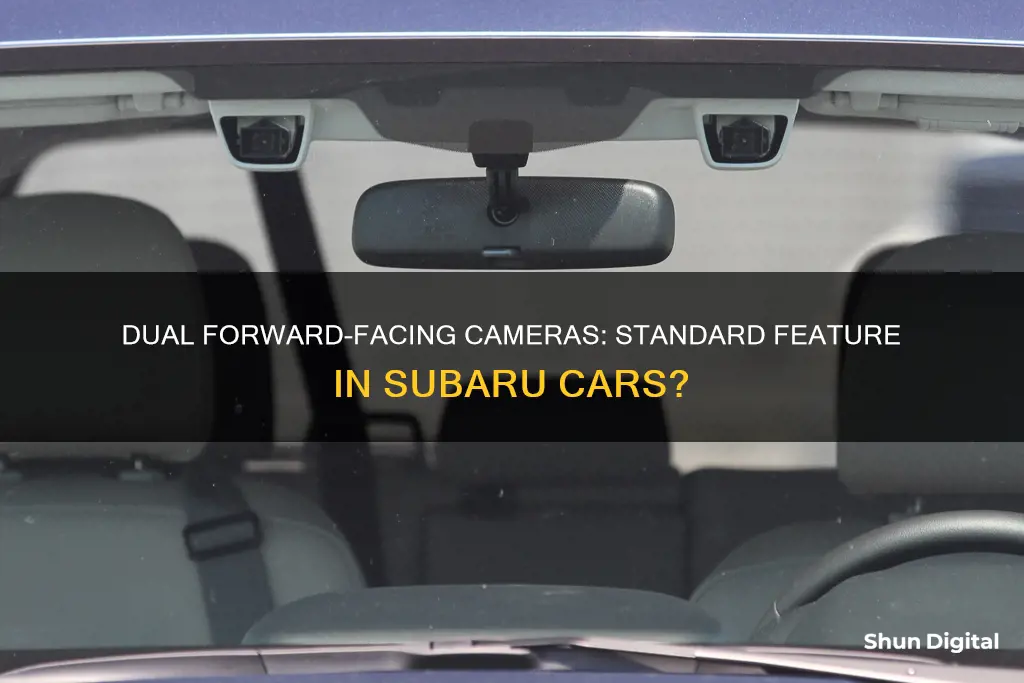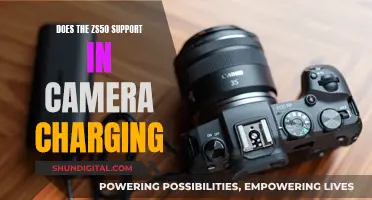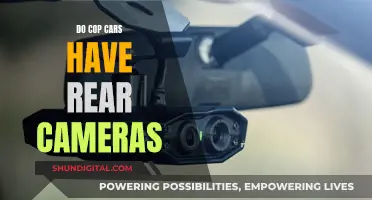
Subaru's EyeSight system, available on all models except the BRZ, features dual forward-facing cameras that record footage and assist with advanced driver-assistance features such as adaptive cruise control, automatic emergency braking, and lane-keeping. The cameras are positioned above the centre rear-view mirror and record footage on a 22-second loop. While Subaru claims the footage cannot be accessed without a court order or written permission from the owner, concerns have been raised about privacy and the potential for authorities to gain access to the recordings.
What You'll Learn
- Subaru's dual-camera EyeSight system records footage and can be accessed by authorities
- The EyeSight system is an ADAS system that controls lane-keep assist, automatic cruise control and emergency braking
- Subaru's DriverFocus system uses facial recognition to adjust settings for up to five drivers
- The 2023 Outback has a third forward-facing camera to help recognise pedestrians and cyclists
- Subaru's dual-camera EyeSight system uses stereoscopic cameras

Subaru's dual-camera EyeSight system records footage and can be accessed by authorities
Subaru's EyeSight® Driver Assist Technology is an advanced driver assistance system (ADAS) that uses dual forward-facing cameras to monitor the road and enhance driving safety. The cameras are placed near the rearview mirror, providing a wide field of vision to scan for potential hazards. This system not only helps with adaptive cruise control and lane-keeping but also includes pre-collision braking and throttle management features.
The dual-camera EyeSight system does more than just assist drivers; it also records footage. According to Dominick Infante, Subaru's head of communications, the cameras record on a 22-second loop, and this footage can be accessed by authorities if needed. While owners can request to view the last 22 seconds of footage, a court order can also grant access to law enforcement. This practice aligns with the increasing emphasis on privacy protections around event data recorders in vehicles, with 17 states enacting relevant legislation.
The ability to access recorded footage from the EyeSight system can be valuable in various scenarios. For instance, in the event of a fender bender or collision, the recorded footage could help determine fault and liability. Additionally, if there are concerns about driver behaviour, such as distracted or drowsy driving, the footage could provide valuable evidence. This feature ensures transparency and accountability, especially in situations where driver behaviour may have contributed to an accident or incident.
It is important to note that while the dual-camera EyeSight system records footage, Subaru's DriverFocus system, which uses a driver-facing camera, does not record anything. This distinction is essential for addressing privacy concerns, as the DriverFocus system only uses infrared technology to monitor driver behaviour without storing any video data.
Subaru's dual-camera EyeSight system, with its recording capabilities, showcases the company's commitment to both safety and transparency. By providing authorities with access to footage, Subaru ensures that its vehicles not only prevent accidents but also contribute to a more comprehensive understanding of any incidents that may occur on the road. This technology underscores Subaru's dedication to innovation and the well-being of its customers and the wider community.
The Evolution of Camera Lenses: Glass and Beyond
You may want to see also

The EyeSight system is an ADAS system that controls lane-keep assist, automatic cruise control and emergency braking
Subaru's EyeSight system is an advanced driver assistance system (ADAS) that controls lane-keep assist, automatic cruise control, and emergency braking. The system uses two forward-facing stereoscopic cameras, positioned above the centre rear-view mirror, to monitor road markings and other objects, facilitating adaptive cruise control, lane-keeping, and collision avoidance.
The EyeSight system provides drivers with advanced safety features and driving assistance. The stereoscopic cameras, with one on each side of the rear-view mirror, offer a 3D view of the road ahead, enabling the system to accurately perceive depth and distance to objects. This depth perception is crucial for functions like automatic cruise control, where the system adjusts the vehicle's speed to maintain a safe distance from the car ahead.
Lane-keep assist is another vital function of the EyeSight system. By monitoring road markings, the cameras help keep the vehicle centred in its lane, providing gentle steering assistance to prevent unintended lane departures. This feature is particularly useful on long drives or in situations where the driver may be distracted or fatigued.
Additionally, the EyeSight system plays a critical role in emergency braking. The cameras detect obstacles and can apply the brakes autonomously to avoid collisions or mitigate the impact. This functionality enhances overall safety, especially in urban environments with higher risks of pedestrian or cyclist collisions.
The EyeSight system also has data recording capabilities. It records footage on a 22-second loop, which can be accessed by vehicle owners or retrieved by authorities with a court order. This feature can provide valuable insights in the event of an accident or for analysing driving behaviour.
While the EyeSight system offers advanced driver assistance, it is important to note that it does not replace the need for a human driver. The system is designed to assist and enhance the driving experience, but ultimately, the driver is responsible for maintaining control and awareness of their surroundings.
Charging Your Fujifilm FinePix: A Step-by-Step Guide
You may want to see also

Subaru's DriverFocus system uses facial recognition to adjust settings for up to five drivers
Subaru's DriverFocus system is an innovative safety feature that utilizes facial recognition technology to enhance the driving experience for up to five different drivers. This system, introduced in the 2019 Subaru Forester, is designed to adjust various settings according to the recognized driver's preferences.
The DriverFocus system employs a driver-facing camera, strategically placed above the multimedia system. This camera is more than just a passive observer; it actively monitors the driver's eye and head position, detecting signs of drowsiness or distraction. This real-time analysis ensures that the driver is alert and focused on the road ahead.
One of the standout features of DriverFocus is its ability to remember and adjust settings for multiple drivers. It can accommodate up to five different drivers, a significant improvement over the typical two or three profiles offered by other memory systems. When a recognized driver takes the wheel, the system automatically adjusts the memory power seat and mirrors to their preferred settings, providing a personalized driving experience.
The setup process for DriverFocus is straightforward and can be performed using the touchscreen menu. Once set up, the system seamlessly switches between drivers, ensuring that each individual enjoys a tailored driving environment. This level of customization not only enhances comfort but also contributes to overall safety by reducing distractions and ensuring optimal driving positions.
In addition to the DriverFocus system, Subaru also offers its EyeSight advanced driver assistance system (ADAS). This system utilizes dual forward-facing cameras, along with other sensors, to facilitate a range of safety features. These features include adaptive cruise control, automatic emergency braking, lane-departure steering assist, and more. The EyeSight system also records footage on a 22-second loop, which can be accessed by the owner or provided to authorities upon request or subpoena.
History of the Kodak Brownie Hawkeye Camera
You may want to see also

The 2023 Outback has a third forward-facing camera to help recognise pedestrians and cyclists
Subaru has added a third forward-facing camera to its 2023 Outback model as part of the top-level Touring trim. This is in addition to the dual-camera EyeSight advanced driver assistance system (ADAS) technology that comes standard on all 2023 Outbacks. The EyeSight system uses two forward-facing cameras, positioned above the centre rear-view mirror, to monitor road markings and other objects, facilitating features such as adaptive cruise control, automatic emergency braking and lane-departure steering assist.
The third camera on the 2023 Outback's Touring trim is a wide-angle mono camera that works in conjunction with the EyeSight cameras to expand the field of view. This additional camera helps the system to recognise pedestrians and cyclists sooner when the vehicle enters an intersection at low speed. When a cyclist or pedestrian is identified, the EyeSight system alerts the driver and can apply the brakes to avoid a collision.
The inclusion of the third camera on the 2023 Outback is a response to the increasing emphasis placed on pedestrian safety by the federal government and consumer safety organisations. The National Highway Traffic Safety Administration (NHTSA) has been directed to initiate rulemaking to require new passenger vehicles to be equipped with pedestrian automatic emergency braking (PAEB) by 2024. The Insurance Institute for Highway Safety (IIHS) and the Highway Loss Data Institute (HLDI) have gone a step further, petitioning for PAEB that is effective in the dark.
The 2023 Outback made its debut at the New York International Auto Show in April 2022, showcasing this new safety feature. With the addition of the third forward-facing camera, Subaru is enhancing the capabilities of its EyeSight system to better protect vulnerable road users, such as pedestrians and cyclists.
Space Tesla Camera: Did the Battery Die?
You may want to see also

Subaru's dual-camera EyeSight system uses stereoscopic cameras
Subarus dual-camera EyeSight system uses stereoscopic cameras, which provide a 3D picture. This system is an advanced driver assistance system (ADAS) that controls and assists with a number of features, including lane-keep assist, automatic emergency braking, and adaptive cruise control. The cameras are typically positioned above the centre rearview mirror, with one on the left and one on the right.
The EyeSight system is available on most Subaru models, including the Crosstrek, Outback, WRX, and Forester. On the 2023 Outback, for example, the EyeSight system works in conjunction with a third, wide-angle mono camera as part of the top-level Touring trim. This additional camera further expands the field of view to enhance pedestrian and bicyclist recognition when entering intersections at low speeds.
The dual-camera EyeSight system is designed to monitor road markings and other objects to facilitate its various driver assistance functions. It also records footage on a 22-second loop, which can be accessed by the vehicle owner or through a court order in certain situations.
The stereoscopic camera setup in the EyeSight system provides depth perception and improves the accuracy of distance measurement, similar to how human binocular vision works. This technology enhances the system's ability to detect and analyse objects in front of the vehicle, enabling features like automatic emergency braking and adaptive cruise control to function effectively.
The dual-camera EyeSight system is an example of Subaru's commitment to safety and innovation in their vehicles. By utilising stereoscopic cameras, Subaru has implemented a robust and reliable solution for advanced driver assistance, contributing to a safer driving experience for both Subaru owners and other road users.
Button Cameras: How Do They Focus?
You may want to see also
Frequently asked questions
Yes, Subaru cars have dual forward-facing cameras as part of their EyeSight advanced driver assistance system (ADAS).
The cameras monitor road markings and other objects to facilitate features such as adaptive cruise control, automatic emergency braking, and lane-keeping assist.
Yes, the EyeSight system records footage on a 22-second loop. This footage can be accessed by the vehicle owner or by authorities with a court order.
Yes, the BRZ model does not come equipped with the EyeSight system and its dual forward-facing cameras.
It may be possible to add the cameras as an aftermarket upgrade, but it would require purchasing additional parts and potentially dealing with software and wiring issues. It is recommended to consult with a professional or a Subaru dealership for guidance on this matter.







